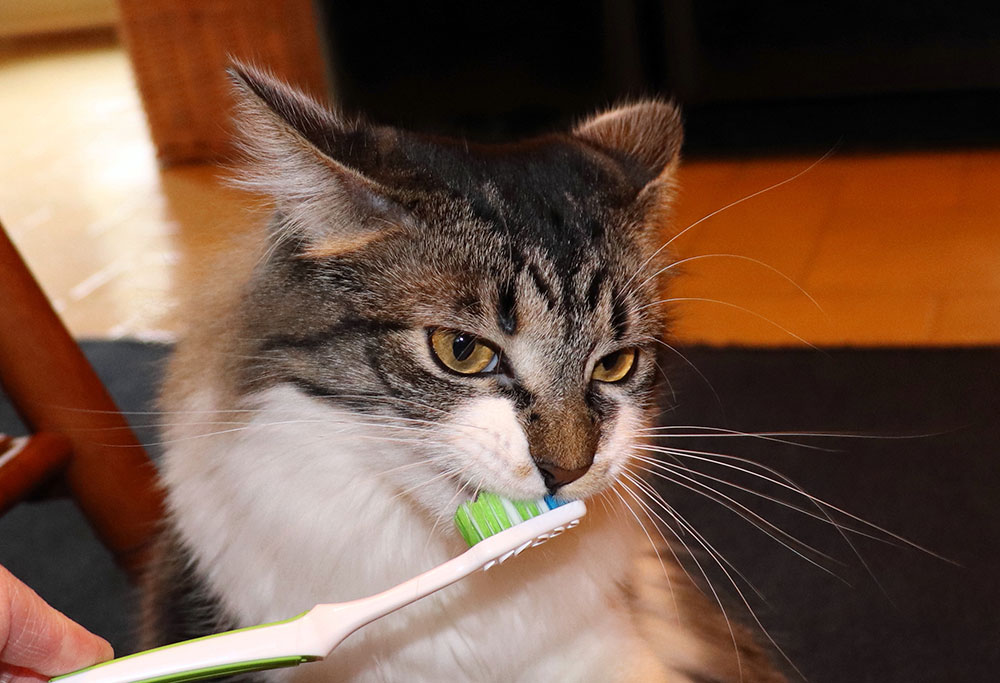How to Brush a Pet’s Teeth, Pet dental Care
Pet Dental Care is essential, Brushing your pet’s teeth is the key to maintaining good oral hygiene. As a result, dental cleaning procedures at your veterinarian are less likely to be simpler (meaning shorter anesthesia time, fewer pulled teeth, etc), your pet’s health may be improved overall (see our wellness plans) , and bad breath (halitosis) is reduced. Brushing the teeth also helps spare a dog or cat oral pain: periodontal disease, a painful condition that occurs when inflammation affects the gums and other tissues around the teeth, is reduced or eliminated with good oral hygiene.
Brushing the teeth is not difficult, and most pets will accept the procedure with a little patience on your part. Primarily, you only need to focus on brushing upper teeth (not the lower teeth), and only the outside surfaces of the teeth (not the inside surfaces).
In dogs and cats, like in people, what the dentist and hygienist do is only a small, though essential, part of the oral hygiene program. The responsibility for health and general well-being of your dog or cat is yours, and this should include basic dental care. Brushing your pet’s teeth is the main component of home dental care. The purpose is to remove plaque before it becomes tartar. Plaque is a slime composed of bacteria, saliva, and food particles that adheres to the teeth and fills the pocket between the tooth and gum. Left undisturbed, plaque rapidly collects minerals from the saliva to form the rock-like brown deposits known as dental tartar. Dental tartar cannot be removed by any amount of brushing. By brushing your pet’s teeth daily, you remove plaque, preventing or slowing tartar buildup. Results depend on the effort you give and on a pet’s predisposition (some develop plaque and tartar easily and require brushing more frequently than others).
GETTING STARTED
Equipment/materials needed:
• Pet toothbrush or child’s/pediatric toothbrush
• Pet toothpaste
It is important to use toothpaste formulated specifically for pets. There are many available in flavors pets like, such as poultry or seafood. Human toothpaste is to be avoided, as it can cause stomach upset if swallowed. Baking soda, with its very high sodium content, can have unintended adverse health effects in dogs and cats with certain illnesses. Hydrogen peroxide can be too harsh for the gums and can cause nausea if swallowed.
Perhaps the most important point to consider is that this simple preventive can become part of a daily routine and, when followed by a treat, becomes something a dog or cat enjoys.
TROUBLESHOOTING BEFOREHAND
It is easy to train pets when they are young to enjoy having their teeth brushed. Older pets, on the other hand, tend to develop more periodontal disease, and their mouths and/or gums may be tender to the touch. A complete dental cleaning under general anesthesia performed by your veterinarian may be required prior to initiating toothbrushing. Once all of the plaque, tartar and, if necessary, diseased teeth have been removed, you will have greater success.
PROCEDURE
1- Try to brush the teeth at the same time each day so your pet gets into a routine. Late in the evening can work well if everyone involved is in a quieter mood. If your pet is highly motivated by food, try just before dinner, with the meal acting as a reward for cooperating.
2- The first step is to work with your pet’s mouth. With a little patience, your pet will soon accept your attention. Make it fun for both of you. Use a lot of love and praise to gain a pet’s confidence.
3- Start by handling the muzzle and lips. Soon you should be able to rub the teeth and gums with your finger. Place a little bit of soft cheese (for dogs) or tuna juice (for cats) on your finger when doing this. Many pets will then look forward to this treat.
4- Next, use a soft toothbrush to brush the teeth.
5- Several veterinary brushes are available, and many human (children’s) soft-bristle brushes are well suited to animal use.
6- Finger brushes are not appropriate as they are ineffective.
7- Place a small (pea-sized) amount of toothpaste on the bristles of the brush, lift the upper lip, place the brush on the outer surface of the teeth, and brush gently in small circles.
8- You need only brush the upper teeth, and only the outside surfaces (the side of the teeth facing out, not the side of the teeth facing the tongue). Making it a game that ends in a reward is the key to enjoying this and making it easy on you and your pet.
9- Brushing at least three times weekly is recommended, and once a day is ideal.
AFTERWARDS
By following a consistent program of home care, you will greatly improve your pet’s dental health. This will mean easier professional cleanings, less tooth loss, and a happier, healthier pet. However, there is no substitute for professional veterinary dental care. The biggest part of the tooth lies underneath the gums, and your pet must be anesthetized (asleep) to work with that “under the gum” area.












Recent Comments